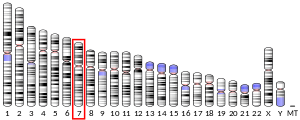CLEC5A
C-type lectin domain family 5 member A (CLEC5A), also known as C-type lectin superfamily member 5 (CLECSF5) and myeloid DAP12-associating lectin 1 (MDL-1) is a C-type lectin that in humans is encoded by the CLEC5A gene.[5][6]
Structurally MDL-1 is a type II transmembrane protein with a short cytoplasmic tail and without signaling motifs, therefore it requires association with the adaptor protein DAP12 to generate signals via Syk pathway.[7]
MDL-1 is highly expressed on myeloid lineages like neutrophil, monocyte, macrophage and also osteoclast, microglia and dendritic cells.[8]
Activation of MDL-1 induces production of many cytokines (TNF-α, IL-1, IL-6, IL-8 and IL-17A) and chemokines (MIP-1α, RANTES, IP-10, MDC). MDL-1 also amplifies innate immune response.[7]
Viral pathology
The most known ligand for CLEC5A is dengue virus (DV). Activated CLEC5A by binding to the dengue virion leads to phosphorylation of DAP12 and through Syk pathway are induced proinflammatory cytokines. CLEC5A is responsible for dengue virus induced hemorrhagic fever (DHF) and dengue shock syndrome (DSS), which is the most severe immune response to dengue virus infection and it is characterized by plasma leakage because of the increased vascular permeability. Interaction of CLEC5A and dengue virus also induces osteolytic activity.[8]
Another pathogen is influenza virus and its hemagglutinin protein, which interacts with CLEC5A. Through this interaction is stimulated innate immune response and it leads to secretion of proinflammatory cytokines.[9]
The researchers discovered that Japanese encephalitis virus (JEV) also binds to CLEC5A and contributes to viral pathology.[8]
Use in therapy
With the discovery of CLEC5A interactions with different viruses, scientists are testing blocking anti-CLEC5A antibodies, Syk pathway inhibitors and CLEC5A deficient mice to discover CLEC5A contribution to pathological progress.
In the case of dengue virus, monoclonal anti-CLEC5A antibodies are able to suppress the secretion of proinflammatory cytokines without affecting IFN-α. Blockade of CLEC5A signaling in DV infected cells can attenuate vascular leakage and increase survival of patients with DHF and DSS.[8]
In lethal challenges of recombinant H5N1 influenza virus, the CLEC5A deficient mice showed reduced levels of proinflammatory cytokines, decreased immune cell infiltration in the lungs and improved survival compared to the wild-type mice even with comparable viral loads.[9]
For the Japanese encephalitis virus, blockade of CLEC5A cannot inhibit infection of neurons and astrocytes, however anti-CLEC5A decreases proinflammatory cytokines and toxic substances released from microglia.[8]
References
- GRCh38: Ensembl release 89: ENSG00000258227 - Ensembl, May 2017
- GRCm38: Ensembl release 89: ENSMUSG00000029915 - Ensembl, May 2017
- "Human PubMed Reference:". National Center for Biotechnology Information, U.S. National Library of Medicine.
- "Mouse PubMed Reference:". National Center for Biotechnology Information, U.S. National Library of Medicine.
- "Entrez Gene: C-type lectin domain family 5".
- Bakker AB, Baker E, Sutherland GR, Phillips JH, Lanier LL (August 1999). "Myeloid DAP12-associating lectin (MDL)-1 is a cell surface receptor involved in the activation of myeloid cells". Proceedings of the National Academy of Sciences of the United States of America. 96 (17): 9792–6. Bibcode:1999PNAS...96.9792B. doi:10.1073/pnas.96.17.9792. PMC 22289. PMID 10449773.
- Cheung R, Shen F, Phillips JH, McGeachy MJ, Cua DJ, Heyworth PG, Pierce RH (November 2011). "Activation of MDL-1 (CLEC5A) on immature myeloid cells triggers lethal shock in mice". The Journal of Clinical Investigation. 121 (11): 4446–61. doi:10.1172/jci57682. PMC 3204838. PMID 22005300.
- Sung PS, Hsieh SL (2019-12-06). "CLEC2 and CLEC5A: Pathogenic Host Factors in Acute Viral Infections". Frontiers in Immunology. 10: 2867. doi:10.3389/fimmu.2019.02867. PMC 6909378. PMID 31867016.
- Teng O, Chen ST, Hsu TL, Sia SF, Cole S, Valkenburg SA, et al. (January 2017). "CLEC5A-Mediated Enhancement of the Inflammatory Response in Myeloid Cells Contributes to Influenza Virus Pathogenicity In Vivo". Journal of Virology. 91 (1). doi:10.1128/jvi.01813-16. PMC 5165214. PMID 27795434.
Further reading
- Joyce-Shaikh B, Bigler ME, Chao CC, Murphy EE, Blumenschein WM, Adamopoulos IE, et al. (March 2010). "Myeloid DAP12-associating lectin (MDL)-1 regulates synovial inflammation and bone erosion associated with autoimmune arthritis". The Journal of Experimental Medicine. 207 (3): 579–89. doi:10.1084/jem.20090516. PMC 2839155. PMID 20212065.
- Chen ST, Lin YL, Huang MT, Wu MF, Cheng SC, Lei HY, et al. (May 2008). "CLEC5A is critical for dengue-virus-induced lethal disease". Nature. 453 (7195): 672–6. Bibcode:2008Natur.453..672C. doi:10.1038/nature07013. PMID 18496526.
- Davila S, Froeling FE, Tan A, Bonnard C, Boland GJ, Snippe H, et al. (April 2010). "New genetic associations detected in a host response study to hepatitis B vaccine". Genes and Immunity. 11 (3): 232–8. doi:10.1038/gene.2010.1. PMID 20237496.
- Ebner S, Sharon N, Ben-Tal N (October 2003). "Evolutionary analysis reveals collective properties and specificity in the C-type lectin and lectin-like domain superfamily". Proteins. 53 (1): 44–55. doi:10.1002/prot.10440. PMID 12945048.
- Drickamer K (October 1999). "C-type lectin-like domains". Current Opinion in Structural Biology. 9 (5): 585–90. doi:10.1016/S0959-440X(99)00009-3. PMID 10508765.
- Watson AA, O'Callaghan CA (January 2010). "Crystallization and X-ray diffraction analysis of human CLEC5A (MDL-1), a dengue virus receptor". Acta Crystallographica. Section F, Structural Biology and Crystallization Communications. 66 (Pt 1): 29–31. doi:10.1107/S1744309109047915. PMC 2805530. PMID 20057064.
External links
- Human CLEC5A genome location and CLEC5A gene details page in the UCSC Genome Browser.



